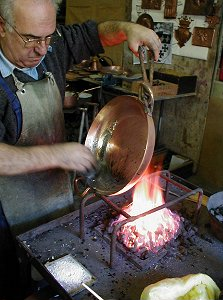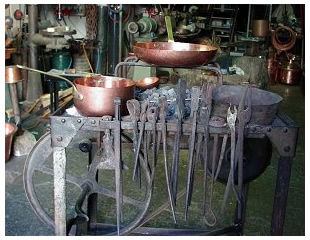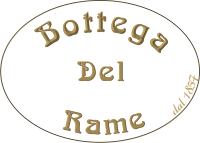Production

The manufacturing process for a tray, as for any other pan, starts with a sheet of pure copper. The thickness of the copper sheet is variable. We use at least 2mm thick sheets.
We have experienced that when the thickness of the metal foil is below this value, the "piece to fire" can't be re-tin plated.
In other words: they are products of poor durability and value.
On the other hand, thinner foils which are more easily mouldable, are ideal for our artistic creations.
For the production of copper products, techniques that have developed from century-old traditions are followed.
We have already talked about this in the copper in history page, but it is necessary to do it again.
Of course, the current tools are different, certainly more effective than those used in ancient times; yet, they are not so different. 
When I can, I am very happy to solder with my coal-fired old forge, which dates back to 1845.
Using a specific gas cooker to bring the work piece to the desired temperature is clearly much more convenient and quick.
The result is identical, even if the procedure is much less romantic.
Hammering
The first phase consists in hammering the sheet to start its curving, according to the traditional method.
Nowadays, we can avail ourselves of some devices that speed up the work, but it is essential that the entire process be characterized by that alternation of heat, hammering and cooling needed to make the pot practically eternal.
This phase may last from two to four hours or more, depending on the shape and size of the object.
Handcrafted copper cookware has features that no industrial process can reproduce.
Pots made with cold working lathe are often available for sale.
This is a procedure that artisans refrain from using since it doesn't ensure uniform thickness of copper.
Finishings
Before tinning, and once created the shape, handles are applied using well hammered copper rivets.
The inside part of the pot is then cleaned and degreased for tinning.
After tinning, the outside part of the pot is cleaned with a polishing brush or by hand, to enhance the natural colour of copper.
Tin-plating
Tin plating pots is an art. An object brought to a temperature of 536° - 572° F (280° - 300° C, melting point of pure tin) is worked by hands.
Only hand-hammered pots can bear such a temperature without deforming.
For this reason, industrial pots, lathe-turned by foils which are not hammered and thinner than those workable by hands, cannot be tinplated.
They are almost always alla pasta tinned (pasta is a composition based on tin which melts at much lower temperatures), or even through galvanization.
In both cases the risk is that daily use will cause tin-plating to degrade rapidly, until it melts completely.
Furthermore, it cannot be excluded that these compositions may even contain traces of toxic metals, especially lead and antimony.

